Lynne Rees's Blog, page 12
April 26, 2019
On not giving up...
An insertional Achilles tear sucks! In the middle of last December I stopped at the top of the lane to stretch my calves but when I started running again it felt like my left trainer was rubbing really painfully against the inside of my heel. It wasn't!
Despite rest, ice, and heel raise exercices, every time I undertook short recovery runs (January and February) I was back to the same amount of pain and discomfort. So I slowed down even more: no running at all in March and a tentative half mile walk/run/walk/run at the beginning of April. That hurt too... but it didn't last. Fingers crossed I am now on the road to recovery (literally!)... although today's road was mostly footpath.
This time last year I was running half-marathons ... but I'm not giving up. Oh no. I'm still hungry for running.
Six months without running...
...and here you are back at the beginning, resenting the forced regression and lamenting the future’s uninvited repetitions. But what other choice is there but to move forward? And listen, the wind in the tall trees. And look, the startled russet flash of two foxes through the orchard. And here… the scent of bluebells along the mud-packed path through the woods. Isn’t everything a new start, every single day? You are not as disadvantaged as you might believe.


Despite rest, ice, and heel raise exercices, every time I undertook short recovery runs (January and February) I was back to the same amount of pain and discomfort. So I slowed down even more: no running at all in March and a tentative half mile walk/run/walk/run at the beginning of April. That hurt too... but it didn't last. Fingers crossed I am now on the road to recovery (literally!)... although today's road was mostly footpath.
This time last year I was running half-marathons ... but I'm not giving up. Oh no. I'm still hungry for running.
Six months without running...
...and here you are back at the beginning, resenting the forced regression and lamenting the future’s uninvited repetitions. But what other choice is there but to move forward? And listen, the wind in the tall trees. And look, the startled russet flash of two foxes through the orchard. And here… the scent of bluebells along the mud-packed path through the woods. Isn’t everything a new start, every single day? You are not as disadvantaged as you might believe.


Published on April 26, 2019 09:41
March 14, 2019
Morfa: In Memory of Lives Lost
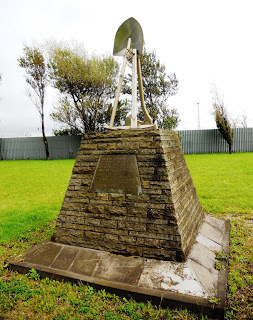 Morfa Colliery was sunk on Margam Moors (now situated within the town of Port Talbot, South Wales) between 1847 and 1849 by Messrs. Vivian & Sons to feed their copperworks at Taibach. It was known as a 'gassy' mine and there were six explosions there between its opening and closure in 1913.
Morfa Colliery was sunk on Margam Moors (now situated within the town of Port Talbot, South Wales) between 1847 and 1849 by Messrs. Vivian & Sons to feed their copperworks at Taibach. It was known as a 'gassy' mine and there were six explosions there between its opening and closure in 1913.188 men, maybe more, died at Morfa during those years and a memorial to them has been erected, near to the original site of the mine, within the TATA Steel plant in Port Talbot.
I wrote the following poem for a memorial service held on site on 8th March, 2019.
Mrs Peppin
John Peppin, b.1857, was one of 87 men killed in the Morfa Colliery Explosion on 10th March 1890. His body was not found until December 1894,one of the last to be recovered. Around 15 men were never located and remain entombed in the old mine workings.
Mary Ann Peppin’s hat, shawl and jacket, which she wore to her husband’s funeral on 15th December 1894, are held in a collection at the National Museum of Wales.
It is an unearthly thing to bury a man almost five years dead. You swing from cold grief to release, from the ache you still carry in your blood and bones to the comfort of the hymn you sing in the Chapel of Ease. It is cold today. Your two youngest girlsfour and six, have stayed at home. The two boys fidget next to youon the wooden pew, the memories of their Dad as faint as ghosts.Your eldest stares ahead, her face as pale as your jacket’s lace trim.
And all the years between then and now spill their dread and fear through this vault of stone and glass: the first news of the blast hammered on your door in Brick Row, the two miles you ran in the coal-black dark, breath nettling in your throat, to join the other women praying and crying at the mouth of the pit. You kept vigil for as long as you could until your breasts ached with so much milk you ran home again to feed the baby.
You remember the candles in the windows: West End, Chapel Row,Inkerman, the Constant, flickers of hope and pain, and Mrs Jenkinsweeping for days through the Row’s thin walls after her boy was brought up dead. And on it went, weeks, months, and then the years: men recovered from the seams and delivered back to earth. The mind has curious ways. Even after they flooded the pitsome mornings you’d wake sure of seeing his sweat-streaked face.
You never did again. Not after they came on Tuesday and told you he’d been found tucked in an air-pocket in the Cribbwr seam. ‘In a wonderful state of preservation,’ someone said and someone elsekicked him in the leg. And not when Roderick’s brought the coffin:you told them to be sure it was sealed. The vicar’s drawing to a close.You stand and watch the bearers take your husband’s weight
upon their shoulders, and draw your children near. Poor dabs.And not just yours. How many was it? 200 the papers said. And 69 widows. Outside the chapel a sudden gust lifts the ribbons on your hat, black streams of silk in the wounding winter air. The ground is hard beneath your feet. You make yourself smile for your children’s sake, look them in their trembling eyes and thinkabout the men still waiting to be found. ‘Your Dad’s home,’ you say.

Published on March 14, 2019 12:05
November 12, 2018
Food Stories ~ Cauliflower Cheese
Did you know: you wouldn't be ordering Aloo Gobi (Potato & Cauliflower) in an Indian restaurant if it hadn't been for the British introducing cauliflower to India at the beginning of the 19th century? And that we got it from Cyprus... with their extensively used white or bechamel type sauce translating into cheese sauce at some point?
Mrs Beeton published a Cauliflower Cheese recipe in her Book of Household Management in 1861 ~
 From Mrs Beeton's Book of Household Management 1912 edition
From Mrs Beeton's Book of Household Management 1912 edition
~ a popular accompaniement to the Sunday Roast even back then, although it wasn't an ingredient of my childhood in South Wales in the 1960s/70s. I think I first heard of it after moving to Jersey in 1978.
And here's a bang up-to-date one from 2018, waiting for the oven. With a kick of Dijon mustard in the cheese sauce and a sprinkling of Paprika.

Love it or hate it?
Mrs Beeton published a Cauliflower Cheese recipe in her Book of Household Management in 1861 ~
 From Mrs Beeton's Book of Household Management 1912 edition
From Mrs Beeton's Book of Household Management 1912 edition~ a popular accompaniement to the Sunday Roast even back then, although it wasn't an ingredient of my childhood in South Wales in the 1960s/70s. I think I first heard of it after moving to Jersey in 1978.
And here's a bang up-to-date one from 2018, waiting for the oven. With a kick of Dijon mustard in the cheese sauce and a sprinkling of Paprika.

Love it or hate it?
Published on November 12, 2018 06:44
November 8, 2018
The Village Remembers 1918 ~ 2018
 The Village Green, Offham, Kent
The Village Green, Offham, Kent100 years later and here they are on the Village Green ~
fifteen local men, seamen and soldiers,
some barely out of their teens before they fell.
Remember them crouched in trenches, crossing fields,
on the decks of ships, in the bodies of submarines,
never imagining themselves memorialised
a century away from the mud and guns, the gas,
a burning sea in Iraq, France, Belgium, Greece.
I recite their names, their regiments, aloud, tell them
I am alive because my grandfather survived
the Somme. I think they would smile if they could.

 The Village Green, Offham, Kent
The Village Green, Offham, Kent
Published on November 08, 2018 07:57
November 5, 2018
Lunch with a view

As good a place as any to stop for lunch -
the shelter of trees, a view of the tracks,
and today the air still as a well-kept secret.
But you couldn't finsh that last chestnut?
Was it the whistle and rumble of the London train?
A walker and her dog stomping over the bridge?
We dream of unfinished things, what we leave
behind, the could have beens. November, not long
now before that perfect balance of light and dark.
Published on November 05, 2018 02:59
November 2, 2018
Witches and their Strange Pets!
It seems a poem that came out in my first collection had more history behind it than I realised!
"According to a 15th century guide to detecting and eradicating witchcraft, witches were capable of making penises vanish—and some even kept them in nests and fed them oats." Article HERE... and here's my poem.
Penes
Like exotic pets, they have their tender side,
respond to love applied in varying measures,
a firm hand, a stroke to coax them out,
but they don’t hiss or squeal, don’t require
unusual meals of shredded fruit, humidity,
can travel without the need for quarantine.
And they’re volatile in early morning light,
have a tendency to ignore commands,
display their feral side and roam at night.
So keep them confined, release with care.
They flourish under brisk handling; are reduced
to a fraction of themselves by a cold snap.
From Learning How to Fall (Parthian Books 2005)
 The Witches of Eastwick
The Witches of Eastwick
"According to a 15th century guide to detecting and eradicating witchcraft, witches were capable of making penises vanish—and some even kept them in nests and fed them oats." Article HERE... and here's my poem.
Penes
Like exotic pets, they have their tender side,
respond to love applied in varying measures,
a firm hand, a stroke to coax them out,
but they don’t hiss or squeal, don’t require
unusual meals of shredded fruit, humidity,
can travel without the need for quarantine.
And they’re volatile in early morning light,
have a tendency to ignore commands,
display their feral side and roam at night.
So keep them confined, release with care.
They flourish under brisk handling; are reduced
to a fraction of themselves by a cold snap.
From Learning How to Fall (Parthian Books 2005)
 The Witches of Eastwick
The Witches of Eastwick
Published on November 02, 2018 04:23
August 13, 2018
Running

It's about breathing. And it's about
ivy, elderberries and lichen,
about the sound of feet thudding damp earth.
And fields of wheat stalks and rain-soaked hedges.
A honey-coloured foal on the other side of a fence.
The turn in a path that takes you deeper
into the woods, into yourself. About
leaving home and coming home,
and all the roads you've ever taken,
and all the roads that lie ahead.


Published on August 13, 2018 06:22
July 19, 2018
driftwood
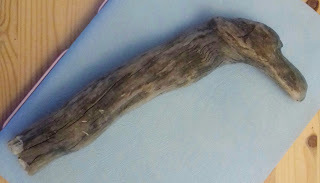 the head and neck
the head and neckof a bird that never existed
in this landscape
of meeting places
river/sea, fresh/salt
pebbled shores rising
to the heaving
shoulders of mountains
or a bird that has always existed
beneath the bark
of a green branch
scoured by Atlantic waves
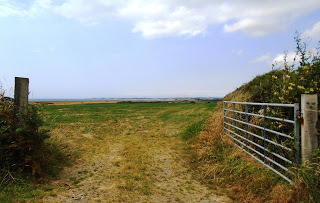 to a fossil of itself
to a fossil of itselfto less than a memory
of sap rising, here
in the palm of my hand
both real and imagined
like an open gate to the sea
what lies beyond
what I want to believe is there
Published on July 19, 2018 12:16
July 12, 2018
Why
Sometimes the things that don't make sensemake sense: a face in a rock, another rockcracked open with the letter Y. My questionbefore I knew I had a question, here nowbetween shoreline and cliff. I find another to fit into the palm of my hand: an answer.

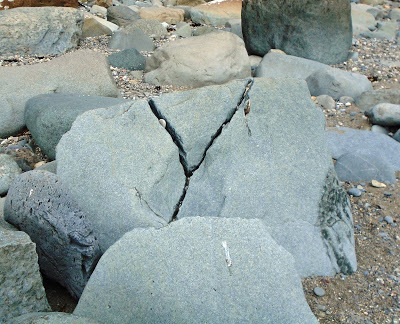

Criccieth, North Wales
12th July 2018



Criccieth, North Wales
12th July 2018
Published on July 12, 2018 07:06
May 12, 2018
Scary Things in the Kitchen 1 - Caramelising Sugar
Fear and courage are subjective. What terrifies me doesn’t raise a shiver in you. What I am happy to face head-on may send you running to the hills. And while nothing is really life-threatening in a kitchen, unless laced with a solid dose of stupidity, there are some things that intimidate me and, as a result, I’ve never tried them. But today I conquered one: caramelising sugar.
 I had visions of uncontrollable breakers of sizzling caramel, of unexpected volcanic eruptions giving me 3rd degree burns. Then I read Nigella’s recipe for Caramel Croissant Pudding and her intro appealed to me so much on a drab, wet Saturday afternoon:
I had visions of uncontrollable breakers of sizzling caramel, of unexpected volcanic eruptions giving me 3rd degree burns. Then I read Nigella’s recipe for Caramel Croissant Pudding and her intro appealed to me so much on a drab, wet Saturday afternoon:
… this is such a fabulous pudding that I now think it should be every Monday night's supper. And I mean supper: with something this substantial, you certainly need eat nothing beforehand.
Just dessert. I’ll go for that.
She also made the caramelisation stage sound like a doddle, and no messing about with thermometers: Caramelise the sugar and water mixture by letting it bubble away, without stirring, until it all turns a deep amber colour; this will take 3-5 minutes. Keep looking but don't be too timid.
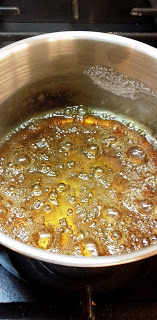 I can do that. And I did. Perhaps with a little trepidation and some over thinking of the degrees of deep amber. Like the translucent stuff wrapped around mosquitoes? Or a darker, closer to cognac, colour? I erred on the side of less is more.
I can do that. And I did. Perhaps with a little trepidation and some over thinking of the degrees of deep amber. Like the translucent stuff wrapped around mosquitoes? Or a darker, closer to cognac, colour? I erred on the side of less is more.
And the result was worth it. Worth more than the final picture suggests because, let’s be honest, it’s always tricky to make brown food look appetising. So just imagine sweet, puffy custardy cushions of caramel flavoured croissant spiked with Jim Beam*.
I was happy to eat this on its own - there's enough milk, cream and eggs in it already. Vanilla ice-cream would be nice though. Or a dollop of creme fraiche.
(*Not, I hasten to add, that I needed the bourbon for courage, although I did, given how long it's been in the back of the cupboard, have a quick swig to make sure it was okay. Best to be on the safe side!)
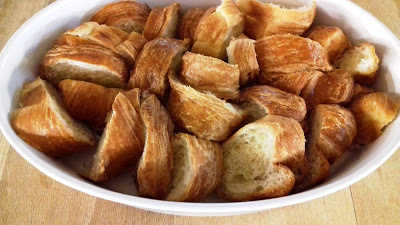 Croissants awaiting a future of caramel custard.
Croissants awaiting a future of caramel custard.
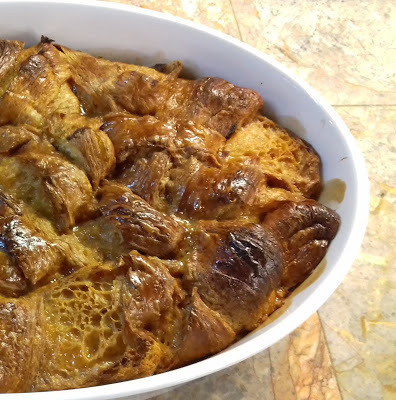 Prepare to swoon
Prepare to swoon
 I had visions of uncontrollable breakers of sizzling caramel, of unexpected volcanic eruptions giving me 3rd degree burns. Then I read Nigella’s recipe for Caramel Croissant Pudding and her intro appealed to me so much on a drab, wet Saturday afternoon:
I had visions of uncontrollable breakers of sizzling caramel, of unexpected volcanic eruptions giving me 3rd degree burns. Then I read Nigella’s recipe for Caramel Croissant Pudding and her intro appealed to me so much on a drab, wet Saturday afternoon:… this is such a fabulous pudding that I now think it should be every Monday night's supper. And I mean supper: with something this substantial, you certainly need eat nothing beforehand.
Just dessert. I’ll go for that.
She also made the caramelisation stage sound like a doddle, and no messing about with thermometers: Caramelise the sugar and water mixture by letting it bubble away, without stirring, until it all turns a deep amber colour; this will take 3-5 minutes. Keep looking but don't be too timid.
 I can do that. And I did. Perhaps with a little trepidation and some over thinking of the degrees of deep amber. Like the translucent stuff wrapped around mosquitoes? Or a darker, closer to cognac, colour? I erred on the side of less is more.
I can do that. And I did. Perhaps with a little trepidation and some over thinking of the degrees of deep amber. Like the translucent stuff wrapped around mosquitoes? Or a darker, closer to cognac, colour? I erred on the side of less is more. And the result was worth it. Worth more than the final picture suggests because, let’s be honest, it’s always tricky to make brown food look appetising. So just imagine sweet, puffy custardy cushions of caramel flavoured croissant spiked with Jim Beam*.
I was happy to eat this on its own - there's enough milk, cream and eggs in it already. Vanilla ice-cream would be nice though. Or a dollop of creme fraiche.
(*Not, I hasten to add, that I needed the bourbon for courage, although I did, given how long it's been in the back of the cupboard, have a quick swig to make sure it was okay. Best to be on the safe side!)
 Croissants awaiting a future of caramel custard.
Croissants awaiting a future of caramel custard. Prepare to swoon
Prepare to swoon
Published on May 12, 2018 08:10



